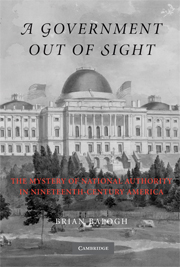Book contents
- Frontmatter
- Contents
- Acknowledgments
- 1 Introduction: Why Look Back?
- 2 How Americans Lost Sight of the State: Adapting Republican Virtue to Liberal Self-Interest
- 3 Between Revolutions: The Promise of the Developmental Vision
- 4 “To Strengthen and Perpetuate that Union”: Republican Political Economy
- 5 Outside the Boundaries: “Powers and Energies in the Extreme Parts”
- 6 The Uncontested State: Letters, Law, Localities
- 7 Restoring “Spontaneous Action and Self-Regulation”: Civil War and Civil Society
- 8 Judicial Exceptions to Gilded Age Laissez-Faire
- 9 “A Special Form of Associative Action”: New Liberalism and the National Integration of Public and Private
- 10 Conclusion: Sighting the Twentieth-Century State
- Index
9 - “A Special Form of Associative Action”: New Liberalism and the National Integration of Public and Private
Published online by Cambridge University Press: 05 August 2012
- Frontmatter
- Contents
- Acknowledgments
- 1 Introduction: Why Look Back?
- 2 How Americans Lost Sight of the State: Adapting Republican Virtue to Liberal Self-Interest
- 3 Between Revolutions: The Promise of the Developmental Vision
- 4 “To Strengthen and Perpetuate that Union”: Republican Political Economy
- 5 Outside the Boundaries: “Powers and Energies in the Extreme Parts”
- 6 The Uncontested State: Letters, Law, Localities
- 7 Restoring “Spontaneous Action and Self-Regulation”: Civil War and Civil Society
- 8 Judicial Exceptions to Gilded Age Laissez-Faire
- 9 “A Special Form of Associative Action”: New Liberalism and the National Integration of Public and Private
- 10 Conclusion: Sighting the Twentieth-Century State
- Index
Summary
In the spring of 1885, a group of economists representing the “new school” of economics issued a statement that founded the American Economic Association (AEA). The AEA, in turn, was a key contributor to the “new liberalism” that emerged in the late nineteenth century and forged the intellectual foundation for the Progressive Era. Among the leaders of the American Economic Association were such prominent economists as Henry C. Adams, John Bates Clark, Richard Ely, and Edwin R.A. Seligman. Their platform was endorsed by prominent clergymen engaged in social reform, including the Rev. Dr. Lyman Abbot and the Rev. Dr. Washington Gladden. Carroll D. Wright, Commissioner of the U.S. Bureau of Labor, also lent his support. Several aspects of the AEA's platform raised eyebrows among Americans schooled in the political economy of laissez-faire. But no statement drew as much attention as the first sentence of the platform, which proclaimed, “We regard the state as an educational and ethical agency whose positive aid is an indispensable condition of human progress.”
Seeking to disseminate the core principles of this new approach to its readers, Science provided a platform for economists from the new school of economics in a series of essays sprinkled through its 1886 volumes. Critics of the new approach, most prominently William Graham Sumner, were also invited to contribute. Those looking for a knockdown, drag-out fight must have been disappointed. Despite essays by Ely, Seligman, and E.J. James, one critic complained that the new school had pulled its punches. There had been little discussion of the main point of difference between the “old school,” and the new: “that it looks with more favor upon government intervention in the process of industry and trade.”
- Type
- Chapter
- Information
- A Government Out of SightThe Mystery of National Authority in Nineteenth-Century America, pp. 352 - 378Publisher: Cambridge University PressPrint publication year: 2009
- 1
- Cited by



